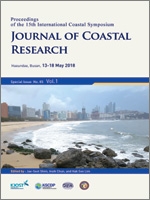Kim, W.; Yi, J.-H.; Min, I.K., and Shim, J.S., 2018. Monitoring of structural dynamic characteristics of Sochengcho Ocean Research Station. In: Shim, J.-S.; Chun, I., and Lim, H.S. (eds.), Proceedings from the International Coastal Symposium (ICS) 2018 (Busan, Republic of Korea). Journal of Coastal Research, Special Issue No. 85, pp. 1191–1195. Coconut Creek (Florida), ISSN 0749-0208.
In order to study ocean and meteorological changes related to the global climate change and the global warming, Korea is operating several ocean research stations (ORS) such as Ieodo ORS, Gageocho ORS and Socheongcho ORS in remote ocean area. In July 2011, Typhoon Muifa directly hit the Gageocho ORS, and it was damaged to its structural members and various observation devices, unfortunately. After this, the Socheongcho ORS was constructed in 2014, and the structural health monitoring system was instrumented for studying the structural integrity under various external loading conditions. The purpose of this study is to investigate the structural dynamic characteristics of Socheongcho ORS using long-term measurement data including acceleration and tilt responses. Least-square based frequency domain decomposition method is utilized to estimate the natural frequencies and random decremental technique is utilized to estimate the damping ratios in this study. Two natural frequencies for the lower two bending modes are estimated as about 1.39 Hz and 1.43 Hz in weak and strong axes, respectively, and difference is not so significant because the overall shape is almost symmetrical except the superstructure. The natural frequency of the first twisting mode is obtained as about 1.51 Hz, which is slightly higher than the natural frequencies of the bending modes and it can be seen in general jacket structures. It is also found that, when the tilt and acceleration responses are larger, the damping ratios in first mode can be obtained more consistently with lower irregular fluctuations. The damping ratios are found around 5.5 % – 5.8 %. It is expected that the results from long term monitoring can contribute to ensure safe scientific activities by checking the structural safety level of Socheongcho ORS.





